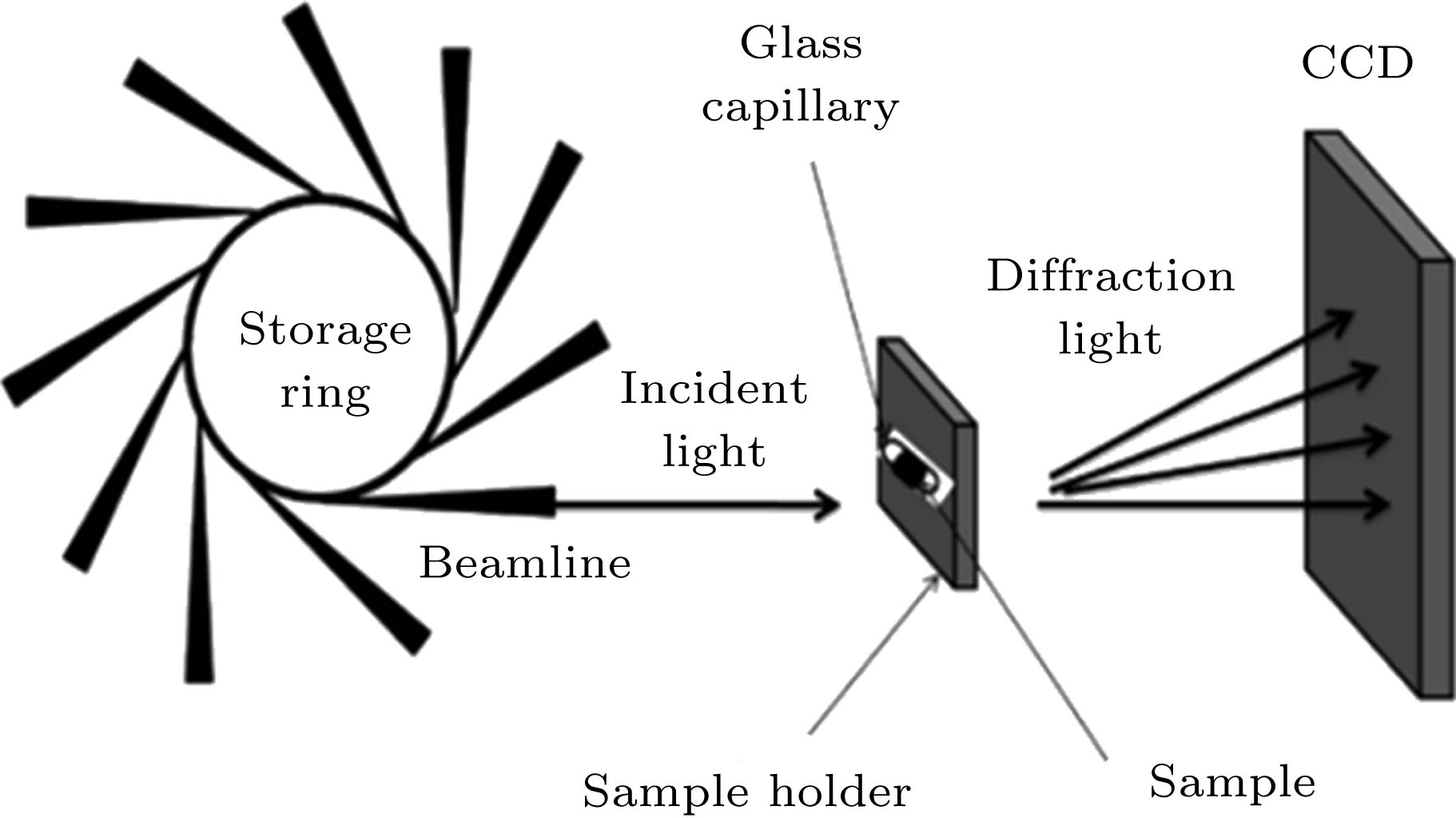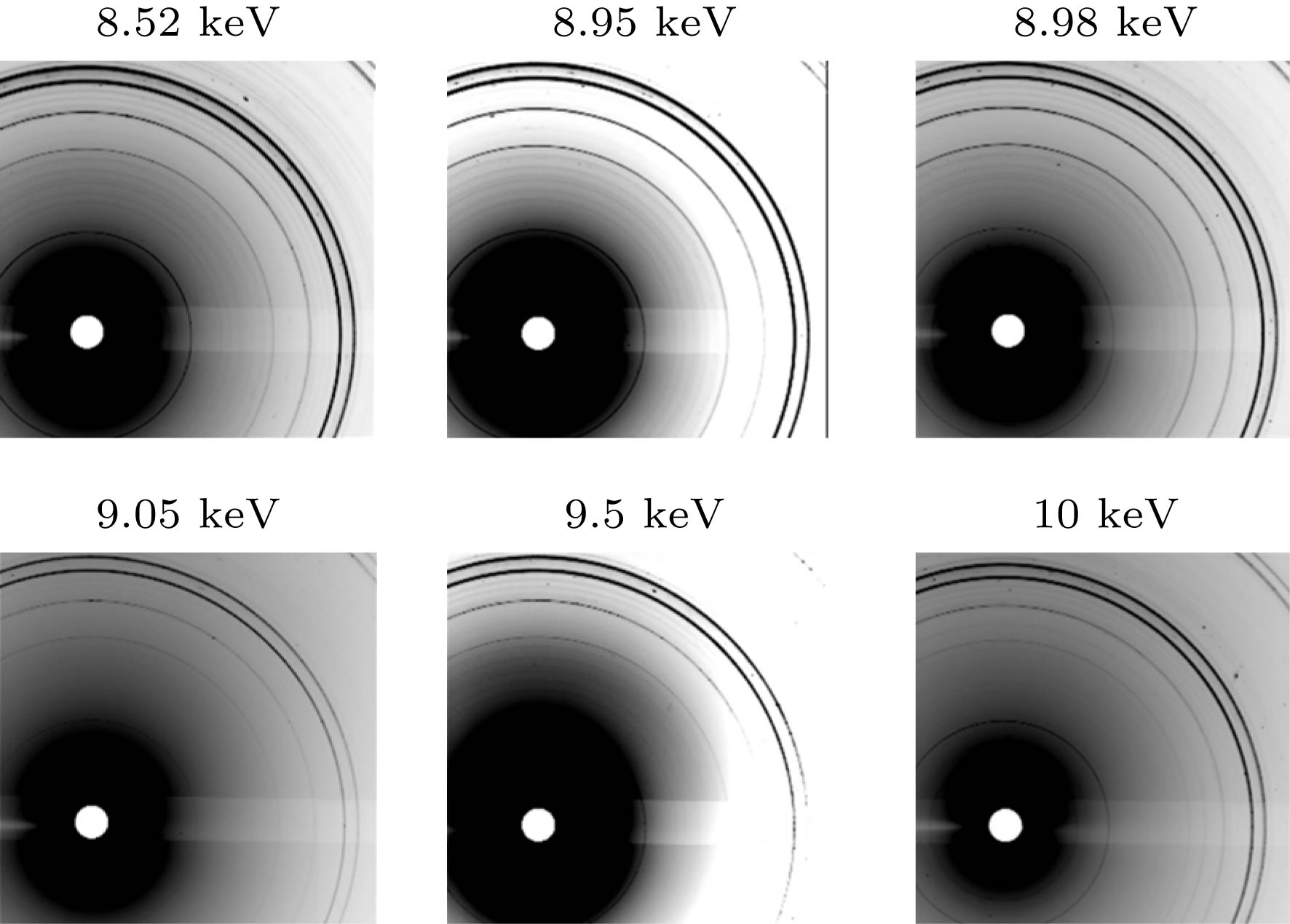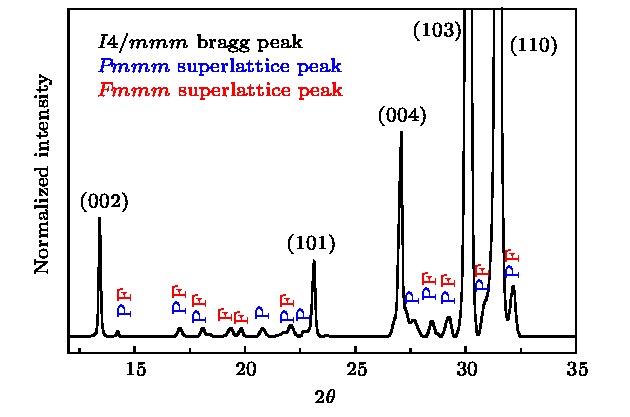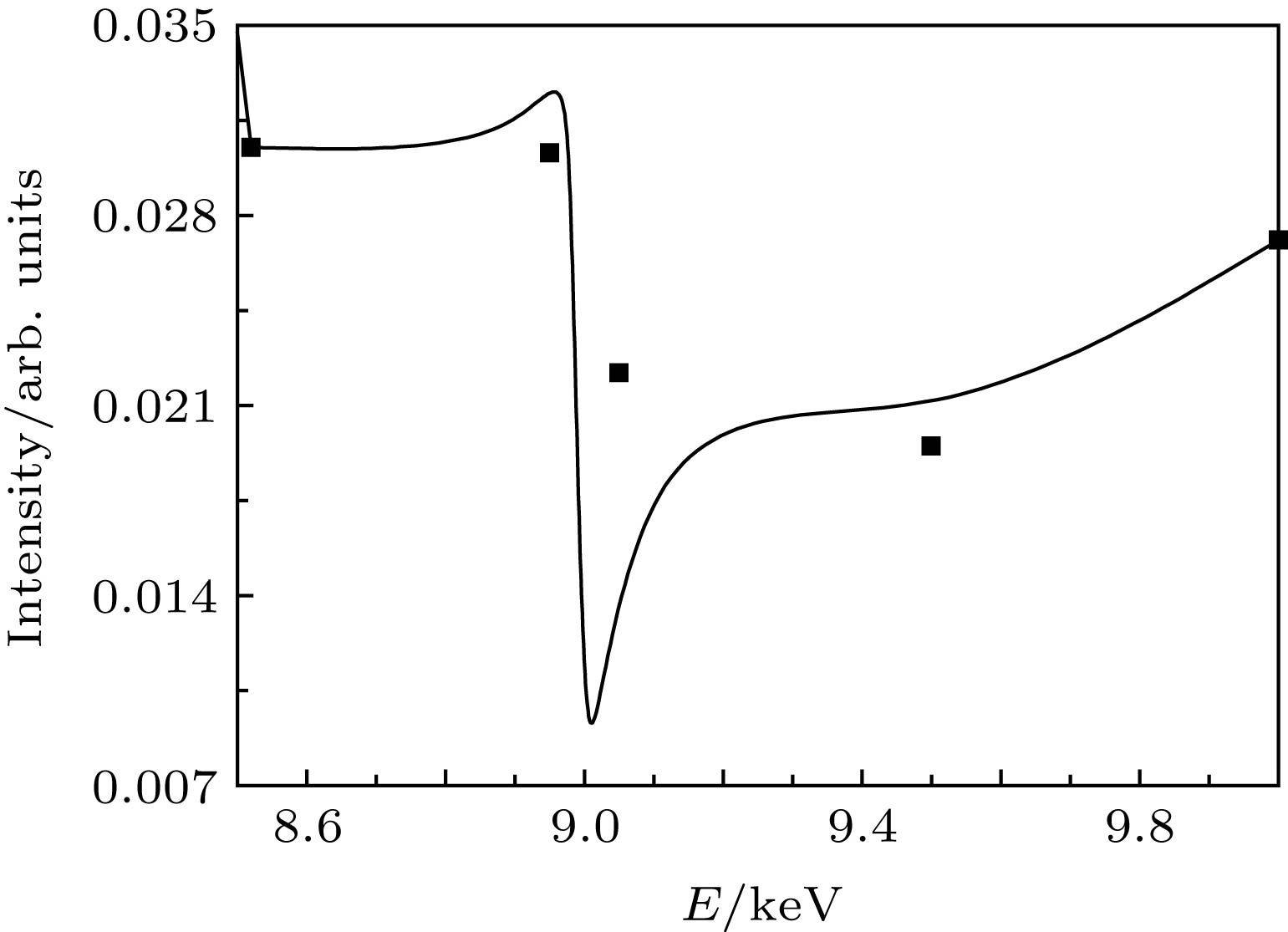-
Sr2CuO3+δ is cuprate, a high temperature superconducting (HTS) material that has a single copper oxide layer and a relatively high critical temperature. Its structure is simple and contains fewer atoms, but there are many modulation structures in it. A lot of studies have pointed out that the modulation structure is related to its superconductivity. In order to further study the relationship between modulated structure and superconductivity in Sr2CuO3.4 HTS sample, a new explanation for the formation mechanism of modulation structure is proposed in this paper. The synchrotron radiation resonant X-ray diffraction (RXD) technique is used to detect the variation of modulation structure near the absorption edge of Cu atom. Cu2+, Cu3+ valence order is detected and used to explain the formation mechanism of modulation structure in Sr2CuO3.4 high temperature superconducting sample. The energy values of incident light are selected to be 8.52, 8.95, 8.98, 9.05, 9.5, and 10.0 keV near the edge of Cu K. The energy resolution is about 1.5 eV. The detector used in the experiment is Mar165 CCD surface detector. The distance from the detector to the sample is about 315 mm. The two-dimensional diffraction pattern recorded by the CCD plane detector is processed by Fit2D software to obtain the diffraction integral intensity. In addition, the energy calibration for each of the copper foil samples is carried out prior to the start of the experiment and in the process of varying energy value. The experimental results show that the Bragg diffraction peaks corresponding to Tc = 48 K and the modulation structures of Fmmm and Pmmm are visible and calibrated. The intensity of the corresponding (2/5, 4/5, 0) diffraction peak of Fmmm is energy-dependent near the Cu K edge and first increases and then decreases abruptly near the absorption edge. This indicates that a stable ordered arrangement structure of Cu2+ and Cu3+ is formed at this time. The weak diffraction signal of this ordered arrangement structure confirms the fact that the copper-O bonding is stronger. The experiments indicate that oxygen vacancies occupy both the apical position and the CuO2 plane. The ordering arrangement of oxygen vacancies results in the ordering of copper ions with variable valence. The Cu2+, Cu3+ valence order is related to the superconductivity of Sr2CuO3.4. -
Keywords:
- high temperature superconductivity /
- modulation structure /
- resonance X-ray diffraction /
- synchrotron radiation
[1] Hiroi Z, Takano M, Azuma M, Takeda Y 1993 Nature 364 315
 Google Scholar
Google Scholar
[2] Adachi S, Tatsuki T, Sugano T, Ayako Y, Tanabe K 2000 Physica C 334 87
 Google Scholar
Google Scholar
[3] Shimakawa Y, Jorgensen J D, Mitchell J F, Hunter B A, Shaked H, Hinks D G, Hitterman R L, Hiroi Z, Takano M 1994 Physica C 228 73
 Google Scholar
Google Scholar
[4] Zhang H, Wang Y Y, Marks L D, Dravid V P, Han P D, Payne D A 1995 Physica C 255 257
 Google Scholar
Google Scholar
[5] Yang H, Liu Q Q, Li F Y, Jin C Q, Yu R C 2007 Supercond. Sci. Technol. 20 904
 Google Scholar
Google Scholar
[6] Liu Q, Yang H, Qin X, Yang L X, Li F Y, Yu Y, Yu R C, Jin C Q, Uchida S 2007 Physica C 460−462 56
[7] Liu Q Q, Yang H, Qin X M, Yu Y, Yang L X, Li F Y, Yu R C, Jin C Q, Uchida S 2006 Phys. Rev. B 74 100506
 Google Scholar
Google Scholar
[8] Liu Y, Shen X, Liu Q Q, Li X, Feng S M, Yu R C, Uchida S, Jin C Q 2014 Physica C 497 34
 Google Scholar
Google Scholar
[9] Nazarenko E, Lorenzo J E, Joly Y, Hodeau J L, Mannix D, Marin C 2006 Phys. Rev. Lett. 97 056403
 Google Scholar
Google Scholar
[10] Ohgushi K, Yamaura J I, Ohsumi H, Sugimoto K, Takeshita S, Tokuda A, Takagi H, Takata M, Arima T H 2013 Phys. Rev. Lett. 110 217212
 Google Scholar
Google Scholar
[11] Dmitrienko V E, Ovchinnikova E N 2000 Acta Crystallogr. 56 340
 Google Scholar
Google Scholar
[12] Tanaka A, Chang C F, Buchholz M F, Trabant C, Schierle E, Schlappa J, Schmitz D, Ott H, Metcalf P, Tjeng L H, Schüßler-Langeheine C 2012 Phys. Rev. Lett. 108 227203
 Google Scholar
Google Scholar
[13] Ovchinnikova E N, Dmitrienko V E 1999 Acta Crystallogr. 55 20
 Google Scholar
Google Scholar
[14] 王海波 2014 博士学位论文 (合肥: 中国科学技术大学)
Wang H B 2014 Ph. D. Dissertation (Heifei: University of Science and Technology of China) (in Chinese)
[15] Hodeau J L, Favre-Nicolin V, Bos S, Renevier H, Lorenzo E, Berar J F 2001 Chem. Rev. 101 1843
 Google Scholar
Google Scholar
[16] Finkelstein K D, Shen Q, Shastri S 1992 Phys. Rev. Lett. 69 1612
 Google Scholar
Google Scholar
[17] Nakamura K, Arima T, Nakazawa A, Wakabayashi Y, Murakami Y 1999 Phys. Rev. B 60 2425
[18] Goff R J, Wright J P, Attfield J P, Radaelli Paolo G 2005 J. Phys.: Condens. Matter 17 7633
 Google Scholar
Google Scholar
[19] Ewings R A, Boothroyd A T, Mcmorrow D F, Mannix D, Walker H C, Wanklyn B M R 2008 Phys. Rev. B 77 104415
 Google Scholar
Google Scholar
[20] Wang H B, Liang W, Liu Q Q, Huang H L, Yang M M, Luo Z L, Yang Y J, Hu S X, Jin C Q, Gao C 2014 J. Electron Spectrosc. Relat. Phenom. 196 61
 Google Scholar
Google Scholar
-
-
[1] Hiroi Z, Takano M, Azuma M, Takeda Y 1993 Nature 364 315
 Google Scholar
Google Scholar
[2] Adachi S, Tatsuki T, Sugano T, Ayako Y, Tanabe K 2000 Physica C 334 87
 Google Scholar
Google Scholar
[3] Shimakawa Y, Jorgensen J D, Mitchell J F, Hunter B A, Shaked H, Hinks D G, Hitterman R L, Hiroi Z, Takano M 1994 Physica C 228 73
 Google Scholar
Google Scholar
[4] Zhang H, Wang Y Y, Marks L D, Dravid V P, Han P D, Payne D A 1995 Physica C 255 257
 Google Scholar
Google Scholar
[5] Yang H, Liu Q Q, Li F Y, Jin C Q, Yu R C 2007 Supercond. Sci. Technol. 20 904
 Google Scholar
Google Scholar
[6] Liu Q, Yang H, Qin X, Yang L X, Li F Y, Yu Y, Yu R C, Jin C Q, Uchida S 2007 Physica C 460−462 56
[7] Liu Q Q, Yang H, Qin X M, Yu Y, Yang L X, Li F Y, Yu R C, Jin C Q, Uchida S 2006 Phys. Rev. B 74 100506
 Google Scholar
Google Scholar
[8] Liu Y, Shen X, Liu Q Q, Li X, Feng S M, Yu R C, Uchida S, Jin C Q 2014 Physica C 497 34
 Google Scholar
Google Scholar
[9] Nazarenko E, Lorenzo J E, Joly Y, Hodeau J L, Mannix D, Marin C 2006 Phys. Rev. Lett. 97 056403
 Google Scholar
Google Scholar
[10] Ohgushi K, Yamaura J I, Ohsumi H, Sugimoto K, Takeshita S, Tokuda A, Takagi H, Takata M, Arima T H 2013 Phys. Rev. Lett. 110 217212
 Google Scholar
Google Scholar
[11] Dmitrienko V E, Ovchinnikova E N 2000 Acta Crystallogr. 56 340
 Google Scholar
Google Scholar
[12] Tanaka A, Chang C F, Buchholz M F, Trabant C, Schierle E, Schlappa J, Schmitz D, Ott H, Metcalf P, Tjeng L H, Schüßler-Langeheine C 2012 Phys. Rev. Lett. 108 227203
 Google Scholar
Google Scholar
[13] Ovchinnikova E N, Dmitrienko V E 1999 Acta Crystallogr. 55 20
 Google Scholar
Google Scholar
[14] 王海波 2014 博士学位论文 (合肥: 中国科学技术大学)
Wang H B 2014 Ph. D. Dissertation (Heifei: University of Science and Technology of China) (in Chinese)
[15] Hodeau J L, Favre-Nicolin V, Bos S, Renevier H, Lorenzo E, Berar J F 2001 Chem. Rev. 101 1843
 Google Scholar
Google Scholar
[16] Finkelstein K D, Shen Q, Shastri S 1992 Phys. Rev. Lett. 69 1612
 Google Scholar
Google Scholar
[17] Nakamura K, Arima T, Nakazawa A, Wakabayashi Y, Murakami Y 1999 Phys. Rev. B 60 2425
[18] Goff R J, Wright J P, Attfield J P, Radaelli Paolo G 2005 J. Phys.: Condens. Matter 17 7633
 Google Scholar
Google Scholar
[19] Ewings R A, Boothroyd A T, Mcmorrow D F, Mannix D, Walker H C, Wanklyn B M R 2008 Phys. Rev. B 77 104415
 Google Scholar
Google Scholar
[20] Wang H B, Liang W, Liu Q Q, Huang H L, Yang M M, Luo Z L, Yang Y J, Hu S X, Jin C Q, Gao C 2014 J. Electron Spectrosc. Relat. Phenom. 196 61
 Google Scholar
Google Scholar
计量
- 文章访问数: 12453
- PDF下载量: 134
- 被引次数: 0














 下载:
下载:





